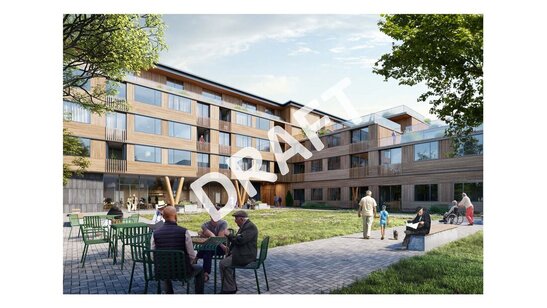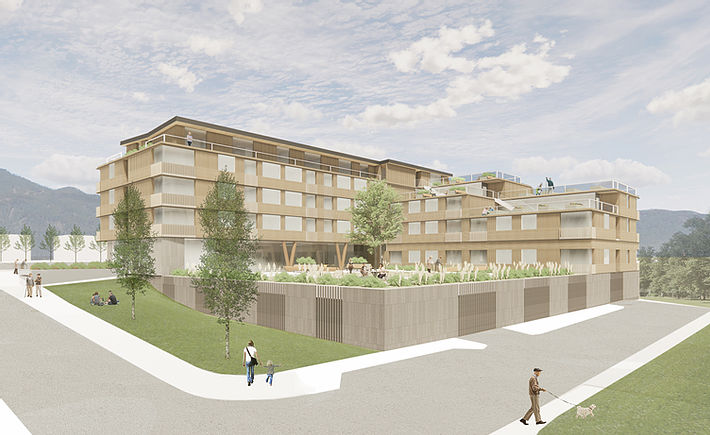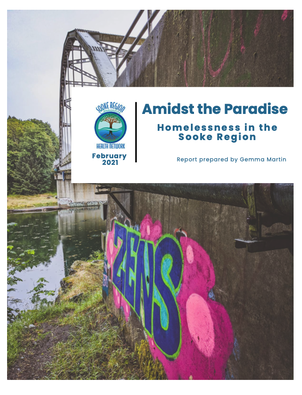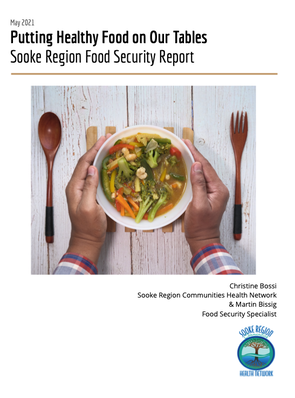Steady, patient progress continues along with some encouraging new developments. Last October, the Sooke Region Communities Health Network and the District of Sooke renewed a letter of understanding stating that the District agrees, in principle, with the overall project and that, should things develop as intended, the northeast portion of Lot A kitty-corner to the new library will be leased long-term for the Sooke Region Elder's Complex.
Since then, SRCHN learned that its Investing in Canada Infrastructure grant bid had come up empty in the face of a record number of applications to the federal program. Yet that news was met with understanding and acceptance as a learning-opportunity prelude to the latest in an unfolding series of long-game strategic moves
For one thing, project leaders led by SRCHN's Mary Dunn have cultivated an ally in the person of BC Seniors' Advocate Isobel MacKenzie. The latter recognizes that Sooke now has the population base that warrants significant investment in a modern multi-generational drop-in centre that will serve the community for the next century. MacKenzie visited Sooke earlier this year, met with Mayor Tait and SRCHN's Dunn and Christine Bossi, and can be counted on to add her voice to local advocacy.
Meanwhile, a VanCity Good Money grant is funding a full-scale business plan for the complex that, among much else, will identify revenue streams that will keep it operating as intended.
And SRCHN has secured Sooke's first-ever grant from the Federation of Canadian Municipalities' Green Municipal Fund. The grant through the Sustainable Affordable Housing stream provides 50% funding for a $200k investment in "detailed architectural, mechanical, electrical and civil engineering drawings" along with net-zero energy modelling calculations for the proposed new-build (which would make the Elder's Complex an exemplary frontrunner for our town's GHG-busting ambitions.)
To fund its share of the FCM grant, SRCHN is asking council to release $100k from the District's Seniors/Youth Facility Reserve Fund, built up (to a maximum of $250k) starting in 2015 through property taxes and currently holding $185k. As Dunn notes in her submission: "With the work done to achieve a net-zero energy efficiency, SRCHN would become eligible to apply for a Green Municipal Fund Capital Grant." If successful, that would fund "20% of the total project costs in a combination of grant and low-interest loan." This will be discussed at council's March 28 meeting (see agenda pp. 215-233.)
The other key piece of the project, of course, would be a successful BC Housing application when the next application window opens, likely in the later half of 2023. The launch of a community fundraising campaign led by Carol Pinalski and friends is also to be expected. Add it all up, and this ever-more sophisticated preparatory groundwork increases the odds for success with the provincial housing authority.
Onwards, then, in the sure confidence that with these skilled #Sooke community builders have the vision, energy and strategic smarts to take this much-needed project across the finish line in due course.
June 2021
Disappointing to learn at last week's council meeting that BC Housing had recently (and apparently reluctantly given the quality of the proposal ) denied a funding request for 79 affordable seniors' rental units in the future Sooke Region Elder's Complex slated for the northeast corner of our town centre Lot A. (Disclosure: I, like you very likely, was among the 83% of Sooke residents who backed the 2014 referendum. And since 2019, I've sat in on many discussions about the project as council's appointee to Sooke's Age-Friendly Committee and also championed it as chair of the District's Lot A Task Force.)
The long-sought dream of a purpose-built seniors/youth gathering place in Sooke (details below) remains very much alive, however, as word is patiently awaited on other grant applications -- notably a $2+ million Investing In Canada Infrastructure proposal that, if secured, would kickstart work on the ground-floor Sooke Seniors Drop-In Centre with its promise of multi-generational programming and the involvement of multiple agencies, including the Sooke Volunteer Centre. That decision from Ottawa is due in the fall. A successful bid would trigger other fundraising initiatives and would allow the centre to proceed with the housing component to follow in time.
BC Housing recently told the Sooke Region Communities Health Network's Age-Friendly Committee team led by Mary Dunn, Rick Robinson, Carol Pinalski, Andrew Moore and Don Brown that they had produced a first-rate proposal in association with consultant Kaeley Wiseman, Victoria-based CitySpaces and the CRD's Capital Region Housing Corporation.
Yet meeting affordable housing needs across BC requires geographically rationed, Solomon-like decisions that invariably can't please everyone. And when the chips landed last month, Sooke wasn't on the list for any of the 2400 new units to win funding in the second round of the province's Community Housing program. (The June 4 announcement cites 47 indigenous and non-indigenous projects across the province; Van Isle recipients are in Comox, Courtenay, Qualicum Beach, Port Alberni, Tofino and Duncan.)
The third-round application window will likely open in 2023 for applications to the $1.9 billion, 10-year lifeline that developed from Premier Horgan's 2018 Homes For BC plan (which followed decades of inaction on the social-housing front from the provincial and federal governments).
And you can be sure SRCHN will get an updated but otherwise largely copy-and-pasted application in the door immediately. (Working group reps are meeting with BC Housing soon to learn how best to refine the pitch and improve the odds next time.)
Along with the downbeat news, it's fair to assume BC Housing advised patience while noting that Sooke has received its share of public funding and favourable housing decisions in recent years:
* Drennan and Sooke Road's 169 units of affordable housing due to open in fall 2023 (June 11, 2021 update here). Total project budget is $46m, with funds from Ottawa augmented by $10.2 million from BC Housing. <clip> "A five-storey apartment building with a mix of studio, one-, two- and three-bedroom homes. The project will provide housing for indigenous peoples, people with low to moderate income, and people with disabilities." (Full details, site plan and drawings in the Nov. 23, 2020 Council agenda, pp. 9-54).
* Charters and Throup Rd's 75-unit, $21 million affordable rental complex expected to be ready for occupancy in fall 2022. BC Housing purchased the land, and the CRD's Regional Housing Trust is contributing $4.5 million of the bill. See Council agenda of Nov. 9, 2020, pp. 7-47).
* BC Housing's $8.5 million purchase of the Hope Centre this last February for transitional housing to be operated by the Sooke Shelter Society. An annual $820k in operating funds is also included. This atop a $1.5 million investment by the province last summer to carve eight new rental units from what was previously commercial space (my beloved quasi-second home, Sooke Yoga & Wellness included) on the building's second floor.
* Funding for the 42-unit Knox Centre on Church Road. It opened in 2019 after nearly a decade of patient, strategic advocacy and hard work by the team led by Knox Presbyterian's former Reverend Gordon Kouwenberg.
* Ongoing BC Housing operational funding support for the Diamond Jubilee Housing Society's apartment building next door to the Legion on Eustace.
For more about housing in Sooke, affordable and otherwise, take a depth dive into Sooke's 2019 Housing Needs Assessment.
The 75-Year (and Counting) Drive for a Seniors' Centre in Sooke
Looking back through this blog, I'm surprised to learn I'd not addressed the long-haul, wonderfully relentless (thanks to stalwarts led by Ms. Pinalski) campaign for a purpose-built senior centre in Sooke. Here's an updated timeline I first prepared when chairing the District's Northeast Quadrant Lot A Task Force in summer 2019 and which is based on Google research + details I found in some of the reports cited here:
1945: Establishment of the Sooke Over '60s Club, percursor to Old Age Pensioners Branch #88 (which was responsible in part for setting up the Sooke Elderly Citizens Society, the Contact Community Assistance Society loan cupboard and Contact drivers service).
1980s: Formation of the New Horizons Activity Society, which evolved into the Sooke Seniors Activity Society (SSAS by name and nature however you want to spell it).
2003: Sooke Senior Drop-In Centre established, first in the Community Hall, then at what was to become Chris Bryant's dental clinic on Sooke Road
August, 2008: Release of An Accessibility and Inclusiveness Study for the District of Sooke, prepared by the Social Planning and Research Council of BC (SPARC)
October, 2008: Sooke Economic Development Commission and Sooke Harbour Chamber of Commerce's An Age-Friendly Sooke: What Can We Do? summary of a day-long dialogue at the Community Hall involving 88 Sooke residents, business owners and service providers chaired by Councillor Rick Kasper.
2010: Seniors' Drop-In Centre relocates to the Sooke Volunteer Firefighters Lounge at the Municipal Hall
March 21, 2013: Seniors' Drop-In Centre Society's Visioning for the Future report prepared by the Society's Pinalski, Gerry Quiring, Martin Quiring and David Bennett in association with Vicki Bennett, Susan Winter & Irene Healey and with support from Nicky Logins (Mayor’s Advisory Panel on Community Health & Social Initiatives) and Marlene Barry (Sooke Region Volunteer Centre).
Fall, 2013: Seniors' Drop-In Centre relocates to downstairs at the Sooke Community Hall (2 days per week)
September, 2014: SRCHN's Getting It Built: Community Centre Report (see pp. 78-11) helmed by Marlene Barry and Ebony Logins.
November, 2014: Municipal plebiscite question: "Would you support the District of Sooke working with the community to develop multi-use community centre facilities?" YES responded 82.9 percent of a 41.5 percent voter turnout. (3072 votes in favour vs. 631 against)
January 2015: Managing At Home: A Study of Sooke Seniors Planning to Remain At Home, prepared by SRCHN's Linda Nehra and Anna Moore in association with West Coast Medical Clinic's Dr. Ellen Anderson and Island Health's Mary Dunn and Emma Isaac. (25% of the respondents noted that social isolation was a critical issue for them, triggering sadness and depression. A central social and activity gathering place was identified as one needed solution.)
Spring 2015: District of Sooke Age-Friendly Action Plan released by SRCHN's official Age-Friendly Committee and endorsed by council. (Powerpoint presentation to Council here).
April 27, 2015: Council motion to create the Sooke Community Centre Advisory Committee chaired by Lee Boyko and featuring reps from the Sooke Community Association, Sooke Fall Fair, SRCHN, Sooke Rotary Club, SEAPARC and Transition Sooke (i.e., yours truly), Ten meetings over 18 months through October 2016.
May 2016: Community Centre Advisory Committee recommendations presented at the May 16 Committee of the Whole meeting. The following reference the recently purchased "new lands" (aka Lot A) in the town centre ...
~ Recommendation #7 (a) "That, along with supporting a new library, Council plan for multi-use community spaces for the residents of Sooke at the newly acquired Wadams Way location. Spaces may include insides areas for a variety of users and an outside 'community square' gathering space."
~ Recommendation #7 (c) "That council direct staff to support Phase 2 of this committee Terms of References that would 'begin a preliminary concept design for use in developing a business case for the multi-use community centre."
~ Recommendation #7 (d) "That council direct staff to explore the feasbility of mixed housing development in conjunction with the community centre use as a means to fund development of a centre; and that council direct District staff to engage with locally successful funded housing project leaders like M'akola Housing to see funding and project planning support."
Nov. 27, 2017: Council delegation by Carol Pinalski representing coalition of Sooke Seniors Drop in Center, Age Friendly Committee and Sooke Region Communities Health Network. Seeking Approval in Principal for 4000 to 5000 sq. ft. activity centre on Lot A.
January 15, 2018: Meeting Pinalski's request, Council began process to authorize the use of a portion of Lot A for a Senior's Drop in Centre, in principle (finalized on May 28). Council discussed (as per minutes):
- A variety of mixed-use including housing on the upper floors and activity space on the bottom, is preferred for the proposed building.
- There is no future commitment if funds are not raised, the District's support provides the opportunity to apply for grants with a potential locale for the facility.
- There was a concern with authorizing facilities or buildings on the property with the absence of a concept plan.
- Council requested a staff report containing an overall vision for Lot A, permitted uses, housing and development plan.
May 18, 2018: Aging With Grace summit meeting at the Prestige
July 23, 2018: Council passed Bylaw No. 717 ~ “The Senior/Youth Centre Reserve Fund will be credited with the 2017 closing balance of $202,578 from the Seniors/Youth Centre Reserve and any monies already approved for 2018 transfer into the Seniors/Youth Centre Reserve.” (i.e., $254k in total)
December 2018: Lot A Charrette at the Municipal Hall involving multiple Sooke stakeholder groups, several of us councillors included. Among the uses identified for the portion of the 5-acre property apart from the library:
"* A home for uses either missing in Sooke or in need of a new home such as affordable seniors housing, senior/youth drop-in centre, health services, office and small retail among others.
* Landscaping and incorporation of existing mature trees and natural drainage channels
* Public plaza for gathering and market space; more permanent home for the Sooke Farmers Market
* How office, commercial, and public space would complement each other to aid current and future residents in Sooke."
May 27, 2019: Final version of Lot A Charrette Concept Plan presented by Keycorp. Endorsed by council unanimously with direction to staff to begin Lot A preparatory work:
i) review Barlett Arborist Report and determine tree retention
ii) Riparian and biological assessment of property
iii) Civil engineer review of property
iv) Rainwater Management Plan for property
v) Rezoning of site (Recommended: P2 on western half; CD Zone for eastern half)
June 24, 2019: Creation of the Northeast Quadrant Lot A Task Force to explore options to develop this section of the property.
Oct. 21, 2019: Committee of the Whole presentation of the business case proposals from the Lot A Task Force. (See minutes, pp. 3-5)
September, 2020: Council approves Elder's Complex proposal.




 RSS Feed
RSS Feed